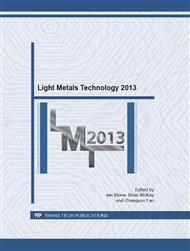p.97
p.102
p.107
p.112
p.117
p.123
p.130
p.135
p.140
Effect of Ca Level on the Formation of Silicon Phases during Solidification of Hypereutectic Al-Si Alloys
Abstract:
In this paper the effect of Ca on the formation of Si phases during solidification of commercial purity Al-15Si alloy was studied. The Ca impurity level of the commercial purity alloy was 200 ppm which was sufficient to lead to a modified Al-Si eutectic. After the addition of K2SiF6 flux the Ca impurity level was 20 ppm which was insufficient to modify the eutectic Si, but primary Si was refined from 48 µm to 20 µm. The refinement of primary Si in Al-15Si alloy fluxed with K2SiF6, suggests that when Ca level is reduced to less than 20 ppm the impurity level of P (≈20 ppm) in commercial purity hypereutectic Al-Si alloys is sufficient to refine the primary Si without any deliberate addition of P. In the case of adding 0.5 wt.% Ca to the Al-15Si alloy, the eutectic Si was highly modified and the primary Si was coarse and irregular in morphology (unrefined). The addition of such a high level of Ca led to enhanced quantities of entrained oxide inclusions/bifilms. The first phase to solidify was Al2CaSi2 which nucleated on the oxide bifilms. Primary Si then formed by nucleation and growth on the Al2CaSi2 particles.
Info:
Periodical:
Pages:
117-122
Citation:
Online since:
July 2013
Authors:
Keywords:
Price:
Сopyright:
© 2013 Trans Tech Publications Ltd. All Rights Reserved
Share:
Citation:


